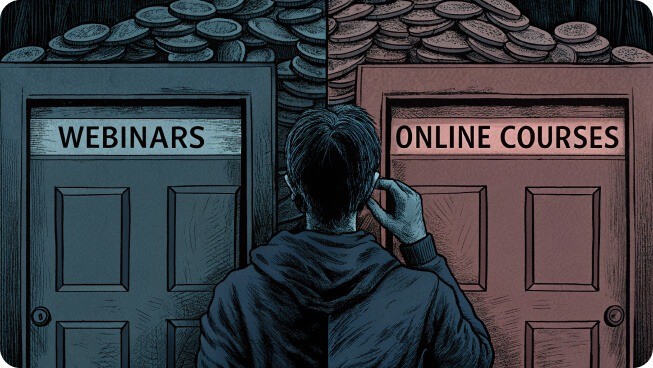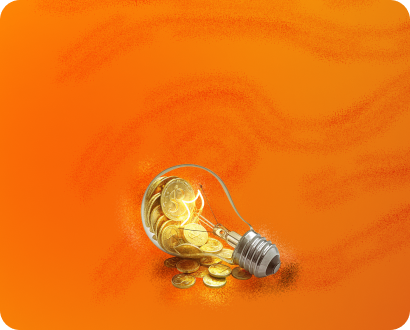In 2025, digital creators are still battling with the same, but sharper, question: webinars vs. online courses for making more money? Both webinars and online courses can generate income, build authority, and drive growth, but they offer different experiences and serve different types of buyers.
The online education space continues to grow despite tremendous competition. Algorithms change, more ad cost and impressions are required, and audiences demand more value for their dollar. What worked in 2020 for selling pre-recorded lessons or endless live learning may not have the same results today.
So, which format earns more money? The answer depends on how quickly you want returns, how much time you have, and how you want to interact with your audience. Webinars create quick wins and real-time experiences, while courses generate ongoing, scalable income. Understanding the trade-offs between the two is essential to finding the right balance for your business model.
Quick Definitions of Both Concepts
Before reviewing profit expectations, let's clarify the two formats.

Webinars are live or pre-recorded online events focused on a singular topic or theme. They usually last 45 to 90 minutes and aim to educate, engage, and/or sell. Some creators charge a nominal fee to attend, while others offer it free, but only to sell an upsell product or service.
There are three types:
-
Live webinars – occurring in real time with chat and Q&A.
-
Automated or evergreen webinars – pre-recorded webinars are scheduled, so the participants feel that they are live.
-
Paid webinars – where the participants pay to attend.
Online courses are structured learning products. They contain many lessons and videos and may or may not show students engaged in their coursework.
Common types:
-
Self-paced – allowing learners to study whenever they want.
-
Cohort-based programs – students advance through with deadlines and feedback.
-
Membership/subscription courses – pay a recurring fee for continual access to updates.
Revenue Paths
Like webinars, online courses can also generate significant revenue; the method of earning money is just different.
Webinars
Webinars can make money through direct or indirect sales funnels. The most prominent revenue sources are:
-
Charge attendees a one-time admission fee.
-
Offer a more expensive coaching program, course, or software during or after the webinar.
-
Funnel webinar attendees into a monthly subscription offer.
-
Get sponsorships or brand deals if you have a large audience.
Webinars tend to have better conversion because they feel personal, and there is generally a sense of urgency to buy during the webinar. Attendees join, interact, and make buying decisions quickly when emotions are high.
Online Courses
Online courses focus more on long-term passive income. Revenue sources include:
-
One-time payment (standard for a course).
-
Tiered pricing with a basic versus a premium version of the course.
-
Bundling (selling several related courses as a bundle).
-
Subscription or membership model (members can stay subscribed and pay monthly to have access to the course).
-
Certification or add-ons (charge for exam, mentorship, community, etc.).
Courses typically provide predictable, slow revenue growth as the number of students increases. Webinars typically experience a spike in revenue when they are first launched or promoted.
Unit Economics (Simple Math You Can Run)
If you treat your content like a business, the numbers get clearer. The basic profit formula is:
Profit = (Price × Conversions) − (Ads + Tools + Time Cost)
Let’s look at a comparison.

Webinar example:
-
You do a live webinar for $49.
-
300 sign up, 60% show up, and 15% buy → 27 purchases.
-
$49 × 27 = $1,323 gross revenue.
-
Subtract $300 on ads and $50 on tools → $973 net.
-
You cash flowed relatively tight and quickly, typically in days.
Course example:
-
You sell a self-paced course for $199.
-
You sold to 2% of a 1,000-lead list → 20 purchases.
-
$199 × 20 = $3,980 gross revenue.
-
After $600 in ads and $200 on tools, yields → $3,180 net.
-
You took longer to finalize sales, but made total revenue in excess of the webinar.
Webinars’ cash flow is quicker but won’t add up to the course price, while courses require time, but have a greater upside once developed. Best creators use webinars to test ideas and fund course creation.
Funnel and Time-to-Cash
The most significant distinction between courses and webinars is in the pace of learning.
Webinar funnel:
-
Attract leads with advertising, e-mail, or social media.
-
They register for a free or paid webinar.
-
You deliver the webinar live or automatically.
-
You deliver a pitch for a product, course, or consultation.
-
Sales happen immediately or within 24 hours to 48 hours.
Which is why webinars are celebrated for instant revenue. You can test offers. You can see results. And use that cash to pay for your next launch to test again.
Course funnel:
-
Build an audience first on a platform (email list, community, YouTube)
-
Nurture with free content and nurture trust.
-
Launch the course with a sales page and a limited-time enrollment offer.
-
Revenue trickles in over weeks or months.
Courses take longer because buyers take more time to purchase. They take more time to invest money and time, and may need to research the investment.
In short, webinars can give you quick income spikes. Courses can provide a steady stream of income over time. Smart creators may cleverly implement both: webinar first for momentum and course second, so secure and steady.
Workload and Scalability
Earning money doesn't just involve making sales. It involves understanding how much effort you are putting into keeping the system going.
Webinars
They require effort and consistency.
Each webinar requires preparation, promotion, and live production. Even recorded webinars require revisions, monitoring, and chat support. A live webinar has authenticity and urgency, but it also reduces scalability, as your time is the biggest expense.
Benefits: immediate feedback, connection to the audience, and high engagement.
Costs: recurring effort, potential burnout, and less automation.
Online Courses
On the other hand, a course is a reward for upfront work.
You'll put in weeks or months to record lessons, write worksheets, and build a platform. But once a course is live, it can sell again and again with minimal effort. You can run ads, affiliate programs, or evergreen funnels while you sleep.
Benefits: income from sales is generally predictable, a consistent customer experience for every buyer, and minimal once a course is built.
Costs: heavy front-end investment and future support (student questions, updates).

In summary, webinars are an easy, quick win, and courses are hard, slow, but scalable. To grow past a certain point, automation and evergreen content will most often prevail over manual.
Positioning in 2025
Buyers are becoming smarter and more discerning in 2025. They compare, read reviews, and expect to see tangible value for their money. This means that your pricing and positioning have never mattered more.
Webinars
Webinars are always best when they offer an easy entry point. Free webinars help develop trust and fill your funnel for future sales. Paid webinars cultivate serious leads and can quickly help you understand demand. Many creators have a “free to paid ladder” — free webinar → low-ticket offer → full program.
Limited-time replays and bonuses, discounted early-bird enrollments, all raise conversions — but authenticity trumps fake urgency.
Online Courses
Courses can be on the higher end of the price range.
In 2025, successful creators deliver tiered pathways:
-
A self-paced option
-
A cohort or mentorship pathway
-
Lifetime or bundled pricing options for repeat customers.
Installment plans, guarantees, and certificates of completion can increase perceived value. What matters more is how you position the offer — you are selling transformation, not information. Buyers are paying for an outcome: mastering a new skill, achieving a goal to increase income, or obtaining a predictable result.
Marketing in 2025
In 2025, attention is the new currency. People scroll faster, skip ads, and engage with creators they trust instead of those who yell the loudest. So no matter if you sell a webinar or a course, again, it’s visibility + credibility.
For webinars, there’s tons of potential with short-form video and live content.
Post micro-clips, quick tips, and behind-the-scenes snippets to spark interest and get sign-ups. Consider these examples:
-
Email sequences with countdowns to signing up or personal invites from you to get them to sign up.
-
Social posts highlighting the main takeaways and value, not your features.
-
Partner promos – guest spots on podcasts and shouting out social or influencer colleagues.
Urgency and live interaction also convert for people signing up. They do webinars because once on-demand is available, people often forget.
For courses, the time cycle of selling is a bit longer. You’re building authority through continual content — having blogs, YouTube tutorials, and free mini-lessons. Evergreen funnels and SEO also work great for marketing and courses.
Building a list is also extremely important: getting leads with free guides, mini-self challenges, or quizzes you can nurture until they are in a buying state of mind. However, consider social proof over ads for this. Share testimonials, or progress screenshots, and examples of what students achieve.

When Each Scenarios Wins
We're not here to debate whether webinars or courses are better. Each is better for a different business purpose.
Webinars are better if:
-
You need cash fast, or you want to validate a concept quickly.
-
Your product/service requires a live explanation or demonstration.
-
You sell coaching, consulting, or higher-ticket offers where the live component builds trust quickly.
-
You are testing audiences or working in a new niche.
If you do one good webinar, you can make a lot of revenue in a single week. Webinars are perfect for a launch, pre-sell, or upsell.
Courses are better if:
-
You want passive income or long-term growth.
-
You are covering a topic in a niche that has consistent and evergreen demand.
-
You want scale based on a system vs a live event.
-
You want to build an educational brand and not just one-time sales.
Courses become digital assets and continue to make money even if you are not running daily promotions.





